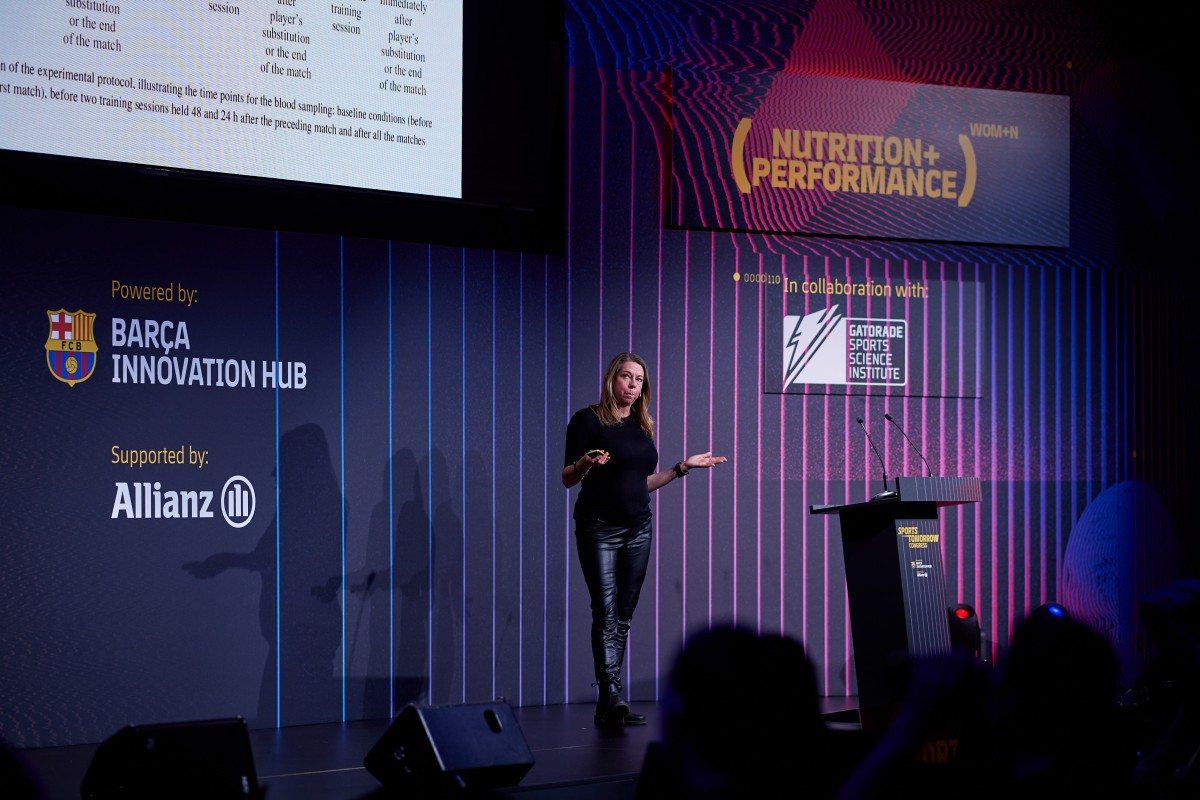How body composition has evolved in women’s football
The evolution of women’s football has been accompanied by changes in body composition. Players are increasingly stronger. Mireia Porta and Dr Antonia Lizarraga, from FC Barcelona nutrition department, have analysed the physical changes that players have undergone in recent seasons. One relevant aspect is the paradigm shift instilled in them: it doesn’t matter how much they weigh but what weighs on them. Increasing and improving the quality of muscle mass was a main goal of coaches after the transition that took place with the professionalisation of women’s football in 2015. In 2014, for example, the percentage of body fat was 25.8%, while in 2021 it was 19%. This change is relevant as it is associated with an increase in muscle mass. In this sense, strength training has been key to promoting the change. During the 2018-2019 season, players trained 28 hours in the gym, while in 2019-2020 it was 40. Conclusion: they are now training more and better. This is in line with a study conducted with the Association of Dietitians-Nutritionists in Spanish Football, which saw that the female teams have improved their anthropometric profile in recent seasons. Fat percentages have decreased and muscle mass has increased.

Dr Lizarrga has provided markers that may be useful for comparing body composition among players. For example, they usually use the muscle mass index (lean mass (kg)/height (m2)) or the muscle mass index of the leg. This is helpful as nutritional and training approaches can be individualised to achieve specific objectives.
Along the same lines, Tyler Bosch, head of data analysis at the Red Bull Athlete Performance Centres, has outlined his work methodology for analysing body composition. It places great importance on the distribution of fat, its symmetry and the changes that occur based on different diet or training approaches. While DXA is an important tool for quantifying body composition, it does not provide quality information. Therefore, they relate these quantitative measures to power analysis protocols such as the CMJ. They correlate quality and quantity values to validate whether the daily work is producing functional improvements.

Gynaecological barriers in elite female sport
Many athletes believe that the menstrual cycle negatively affects their performance. Despite this belief, gynaecologist Ainhoa Cocoa reports that most of them have never consulted a specialist. The presence of menstrual disorders is common, but there are not enough studies on high performance. Not enough is known about the impact of heavy menstrual bleeding, dysmenorrhoea or metabolic syndrome in athletes. For example, research shows that up to 50% of elite British athletes have lost their menstrual cycle at some point. In addition, Dr Cocoa has pointed out that the information they receive from doctors is often contradictory. Therefore, it is necessary to improve the channels of communication with athletes so they are aware that the menstrual cycle is a vital sign of health. She insists that it is very important to promote educational programmes, not only for athletes, but also for trainers, as they must know how to give guidance on improving an athlete’s health and performance, and ensure that their reproductive role is not compromised.
In order to explain how the menstrual cycle is regulated, Carlos Dosouto, a specialist in reproductive medicine at Hospital Sant Pau, has addressed how it can be altered in high-performance sports. A low percentage of adipose tissue (body fat), high workloads or chronic psychosocial stress can trigger an alert in the hypothalamus that alters the reproductive axis and leads to amenorrhoea. Another common alteration in high-performance women is polycystic ovary syndrome, which must be diagnosed and treated appropriately. Because both amenorrhoea and polycystic ovary syndrome have similar symptoms, their approach must be completely different. Therefore, Dosouto has explained how physical examination and imaging are tools needed to control this condition in the best way possible. You have also analysed the role of the birth control pill because in many cases its use is demonised, but, prescribed correctly, it can help players have a regular cycle. Another aspect that he wanted to show is the possibility players have of freezing eggs, as, in the event they want to be mothers, but still want to compete for several more years, this can be a good strategy to preserve healthier eggs, as quality declines over time.
Innovation of nutrition in women’s football
If there is a researcher and nutritionist who has been the main exponent of sports nutrition innovation, it is Dr Asker E. Jeukendrup (University of Loughborough). In relation to female nutrition, the main problem that exists is that most recommendations are made by extrapolating studies done in men. To be able to begin to individualise nutrition in female sport, it is necessary to know the particularities of the female metabolism. Therefore, Juekendrup has analysed the differences that exist at the muscle metabolism level.

One thing for sure is that today, the intensity of football is changing. Players are constantly improving, running faster and further. This generates more muscle damage. In this sense, nutrition can help improve inflammation and the repair processes. Nutritionist Matteo Pincella insists that before integrating supplementation, it is necessary to teach players to eat good quality food. “Supplements should be prescribed to improve a balanced diet, not to replace it.”
One important aspect in the performance and health of the players is to maintain an optimal diversity of the microbiota. The use of probiotics, for example, could help improve bacterial function. Other supplements such as dark chocolate or resveratrol in combination with soya isoflavones have shown antioxidant properties that can improve recovery after training. Pincella has shown the need to study the potential for combining bioactive molecules with evidence to improve inflammation, oxidative stress or mitochondrial function. For example, the use of two fungal supplements such as Cordyceps sinensis and Ganoderma lucidum has been shown to improve the Testosterone/Cortisol ratio in athletes. One thing he wanted to highlight is that we must avoid blocking inflammation after training through excessive use of antioxidants.
Post-match recovery strategies
Physical capacity is reduced after playing a match. Various studies show that neuromuscular markers of fatigue and muscle pain are altered up to 72 hours later. Therefore, accelerating recovery as quickly as possible should be a priority. To achieve this, it is necessary to know how the physiology of the players varies after a game. This has been the topic discussed by Dr Helena Andersson (Swedish School of Health and Sport Sciences), who presented the results of her doctoral thesis in which she analysed the influence of active post-match recovery. It has shown how CK values and muscle pain take almost 3 days to recover. On the other hand, inflammatory markers and oxidative stress take 1. If we talk about glycogen, an important performance marker, the reduction in women is almost 50% after a match, somewhat less than in men. In addition, several studies suggest that women have a greater ability to physically recover, although this could be due to the lower intensity of matches.

What are different recovery strategies? To answer this question, Dr Andersson has analysed the use of different strategies such as ice, compression techniques, improved sleep and rest, or different nutritional aspects.
How does the current lifestyle influence the metabolism of lipids in the muscles?
Today’s lifestyle shows a rise in obesity rates. This is producing a change in muscle metabolism of people who have this pathology. Due to this, Dr Clara Prats (Copenhagen University) explains how this sedentary lifestyle, coupled with a high caloric intake, influences the muscles. Through muscle biopsies, they visualise very precisely what happens in the muscle. The most notable thing is that the energy factories of the cells, the mitochondria, reduce their number and function in the muscle. Its distribution is more spaced out in muscle tissue and has a greater presence of intramuscular lipids. The mitochondrial/lipid relationship decreases in people with obesity. In this sense, training can be a tool to reverse this situation. To improve mitochondrial function and improve the muscle lipid profile, it is necessary to increase daily physical activity, since mitochondria are designed to oxidise the energy substrate on a regular basis.
Historic changes in the FC Barcelona women’s team
The loss of the Champions League final against Lyon Olympique in 2019 meant a change of mindset when working with the players. According to the fitness trainer of the team, Berta Carles, the physical differences they saw in terms of body composition, speed and the strength with which they tackled, led them to propose a new perspective: increased training load. They increased the training load by up to 38% the following season. In addition, intensity also increased, which two years later resulted in this new methodology being translated into a historic treble. Even today, the New York Times confirmed the FC Barcelona women’s team as the most dominant global team in women’s football.
KNOW MORE
CATEGORY: EVENTS
Within the framework of the Sports Tomorrow Congress, Dr. Eva Ferrer, physician of the first female team of the FC Barcelona, and Dr. Gil Rodas, physician in charge of Barça Innovation Hub, they have presented a unique event dedicated to the advancement of the knowledge of female sports.
CATEGORY: EVENTS
Albert Mundet, director of the Barça Innovation Hub, presented the V edition of the Sports Tomorrow Congress, reminding that it is essential to promote the culture of collaboration in the sporting field. These conferences are used to learn about the trends that will transform the world of sports. And this year the central theme of all of them will revolve around the greatest revolution that contemporary sports has known: the incorporation of women into professional categories that were practically reserved for men.
CATEGORY: EVENTS
Sports performance is largely determined by the ability of medical and technical staff to reduce the risk of injury to players and, when they occur, to manage them in the best way possible. Are there differences between men and women when creating a rehabilitation programme?
CATEGORY: EVENTS
Retirement is one of the biggest problems affecting professional female athletes. The salary gap that the female sections suffer does not allow the same proportion of women to finish their career with a secured or resolved future.
CATEGORY: EVENTS
The profile of women’s football is currently rising rapidly, which is helping to boost women’s sport in general. According to Dr Ian Rollo (Gatorade Sports Science Institute), this phenomenon is a resurgence, as in the first decade of the 20th century, women’s football matches attracting more than 55,000 spectators were played in England.
CATEGORY: EVENTS
On a break while preparing their Champions League match against Hoffenheim, the coach of the female FC Barcelona, Jonathan Giráldez, and the players Alexia Putellas and Marta Torrejón have connected with the 5th edition of the Sports Tomorrow Congress of the Barça Innovation Hub on the day dedicated to methodology to explain how they face the most difficult challenge that may exist in the sports competitions: to continue winning after the season.
DO YOU WANT TO KNOW MORE?
- SUBSCRIBE
- CONTACT
- APPLY
KEEP UP TO DATE WITH OUR NEWS
Do you have any questions about Barça Universitas?
- Startup
- Research Center
- Corporate